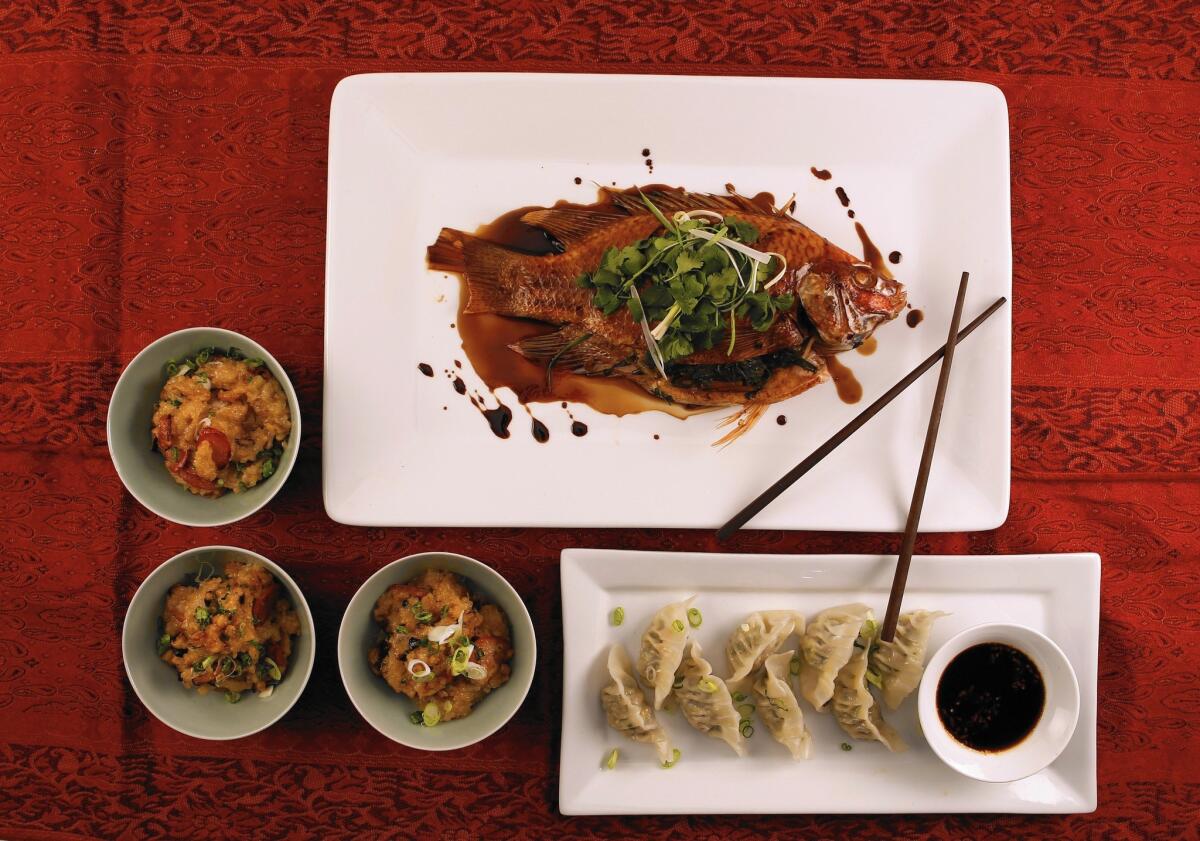Chinese New Year meals in L.A. aren’t strictly traditional

A Chinese New Year meal can include whole fish, dumplings and sticky rice.
- Share via
“To be perfectly frank,” Ling-ya Lee, who came to Los Angeles from Taiwan in 1989, says of her Chinese New Year preparations, “I rarely make dumplings anymore.” Given the high quality of ready-made dumplings available in the Los Angeles area, the La Verne homemaker, now 69, is not alone.
The Year of the Monkey begins on Feb. 8, and for many of the more than a half-million Chinese Americans in the greater Los Angeles area, that means elaborate meals. Some will eat at restaurants with set Chinese New Year menus; others, like Lee, will complement their extensive homemade meals with store-bought foods like the venerated dumplings. Still others will cook their meals from scratch.
“The idea of home-style cooking is a little more cherished in America now,” says private chef Melissa King, 32, who grew up in Hacienda Heights with her Hong Kongese family. “When we do do it, it’s a very special thing.”
Dumpling-making is what Japanese Taiwanese stand-up comedian Atsuko Okatsuka, who is 27 and lives in Silver Lake, loves most about the holiday. “Making dumplings is sort of a family event,” she explains of her Taiwanese grandmother’s “factory-line” approach to organizing her family’s annual dumpling-making party in Arcadia. “We all get to sit together, which doesn’t happen very often. It’s this very ritualistic thing.”
From a cook’s perspective, celebrating Chinese New Year in Los Angeles has its advantages — particularly access to Chinese ingredients in the San Gabriel Valley, which seems to only get better with time.
When King was growing up, she celebrated Chinese New Year with dreary tilapia fillets rather than the all-important whole fish her family eats today. The fish, often grouper, symbolizes abundance and good luck when served in its entirety. King remembers her grandmother’s stories of her youth in Hong Kong, where she would either catch the fish herself, or pick one out from a fisherman’s bucket, still swimming.
“It’s much different now,” King explains of her family’s New Year preparations in Monterey Park. “We just go to the grocery store.”
At the same time, King notes that foods like the slow-fermented salted duck eggs she likes to eat for Chinese New Year with the Cantonese-style sticky rice dish known as loh mai fan are now available ready-made at many Chinese markets in the area. Some say the products here are even better.
“Because we can consume and pay more,” 38-year-old Malaysian Teochew immigrant Iris Loo, a West Covina real estate broker, explains of the vast and affluent Chinese immigrant market in Southern California, “[China] exports the best ingredients here.”
Loo believes her family’s Chinese New Year dishes, such as sea cucumber or abalone — which are dried and imported — are better in Los Angeles than they normally are even in China.
And while Loo’s family prepares a vast homemade meal for the New Year, she also points to the many regional bakeries that sell items such as the glutinous rice cake nian go, a common gift for the holiday: “We actually found a pastry store that makes the nian go exactly as in our hometown.”
Forty-year-old Los Angeles architect Alvin Huang, whose family is from China’s Fujian province and Taiwan but who grew up in the Midwest, says the Southern California area has expanded the palate at his family’s annual New Year hot pot dinner at his mother’s house in Claremont.
“My sister makes a fantastic tahini miso dipping sauce,” he says. Jalapeños and ponzu have also become components of his family’s hot pot meal.
There are some things, though, that simply can’t be found or replicated in Southern California.
Amy Zheng, 27, who immigrated to this country from Chengdu, China, eight years ago, still pines for her mother’s homemade Sichuan sausage. It’s prepared specially for the Chinese New Year.
“It’s the best sausage I’ve ever had,” the Irvine marketing professional says wistfully. However, even though she has access to the specific Sichuan ingredients required to prepare it, she can’t make the fermented sausage here. In the Chinese southern province the links traditionally hang outside on balconies for two cold weeks — something not possible in balmy Southern California.
Store-bought versions are available, but Zheng prefers forgoing tradition rather than a futile search for that elusive taste of home. Instead, she celebrates Chinese New Year in Los Angeles with a potluck meal shared with friends who originate from all over China.
Zheng’s contribution? New York-style cheesecake.
More to Read
Eat your way across L.A.
Get our weekly Tasting Notes newsletter for reviews, news and more.
You may occasionally receive promotional content from the Los Angeles Times.










